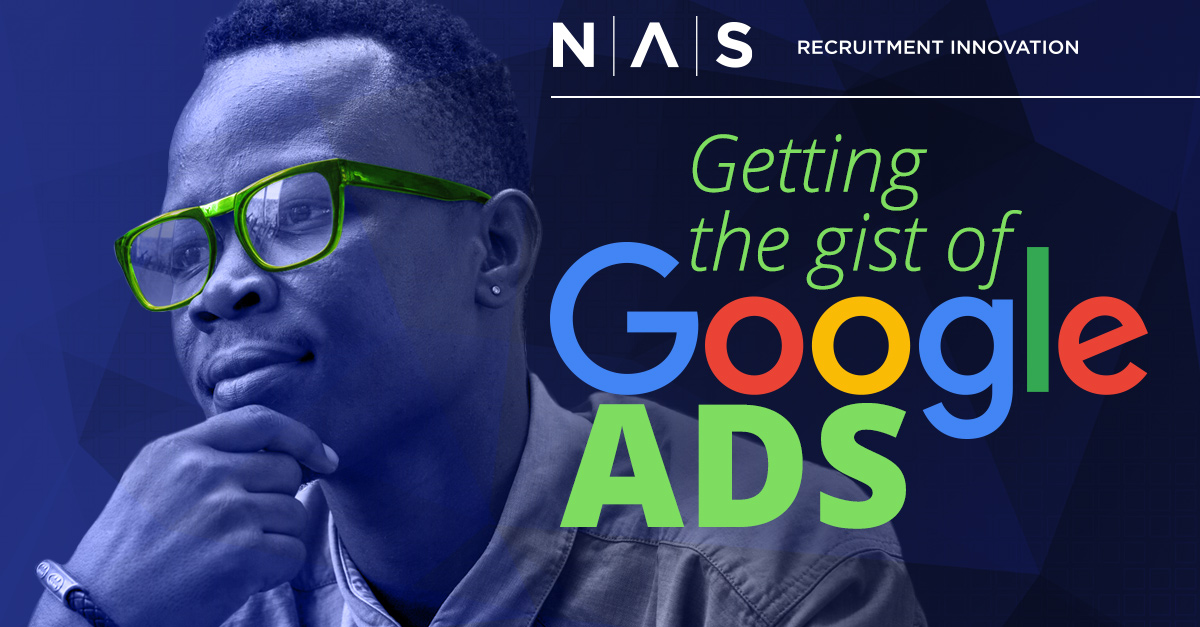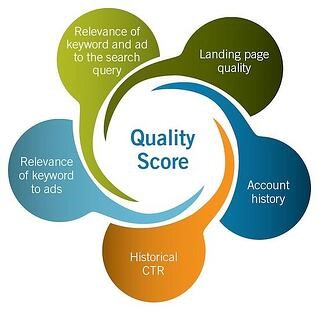-
Getting the gist of Google Ads
Posted by Hannah Dumas on January 8th, 2020 
Making our way in the fiercely competitive landscape of likes and clicks is tough. Fortunately, Google Ads is here to help. Advertising with Google allows you to control your messaging, own your search engine results page (SERP) and build your career brand – all while targeting the candidates you desire.
Google Ads has two components that we use on a daily basis for our clients at NAS, the Search Network and the Display Network.
Google Display Network
The Google Display Network reaches over 90% of internet users worldwide. Google Display is divided into two segments: retargeting and managed placement. Managed placement is all about targeting the audiences and content of websites that are related to what you are promoting, while retargeting is used to keep past visitors to your site engaged.Managed placement advertising allows us to target the passive job seeker. The user may not exactly be in “job search mode” but while going about their normal internet activity they will see your ads, thus creating awareness.
Google Search Network
The Google Search Network is a form of internet marketing in which companies bid on keywords and pay a fee each time one of their ads are clicked on. Google is a pay-per-click model, which means companies only pay when the candidate engages by clicking on the listing. This is important, because you are capturing interested potential employees – not just serving impressions or views to uninterested candidates.Essentially, instead of earning all traffic organically, PPC is a method of buying traffic to your site. To do this, we must bid on keywords that are relevant to the open jobs you are looking to fill or the messaging you wish to promote (Open House, Job Fair, etc.). This allows you to display across the Google Search Network with text ads to those active job seekers that enter certain keywords as a search query.
With 90.46% of search engine market share worldwide, Google receives more than 63,000 searches per second on any given day.
Source: SEO Tribunal
Getting Set
So, where do you begin? After defining your campaign goals (advertised positions, location(s) and time frame), the next step is to conduct keyword research. By ensuring we bid on keywords relevant to the positions our client is looking to fill, and relevant to the company itself, we are able to display the ads in the results when an active job seeker is looking for what the client is “promoting.” We use various tools that assist us with discovering cost, competition and volume for the search terms.It is also imperative that we find that perfect balance between the high-traffic terms, the commercialized terms and the lowest competition terms. After much optimizing and testing, this allows us to achieve an overall lower average CPC (cost-per-click) with an increase in volume while maximizing the overall CTR (click-through rate) for our client to gain both brand awareness and candidate conversion (applications).
We then separate the keywords into like ad groups and create attention-grabbing text ads that are relevant to not only the keywords that are grouped together for the positions that need to be filled, but also for the company and landing page. Many elements are considered when we write the text ads. The choice of language is vital and can have a dramatic impact on the user and whether or not they click on the ad. But in turn, we also want to make sure the right user is clicking on the ad.
Cheat Sheet:
PPC (pay-per-click): The advertising model that charges advertisers only when their specific ad(s) are clicked. With Google Ads, your ads can be seen by thousands of people searching specifically for what you “have” or for what you are “offering,” and you pay nothing until a searcher clicks your ad.
Keywords: The words we bid on for a client that users search on to find the ads
Landing page: The first webpage shown after an ad is clicked. The page is designed to align with the promise made in the ad.
Optimization: Google Ads are not a “set it and forget it” tactic. Optimization involves testing continuously at the beginning of a campaign and routinely throughout in order to maximize your spend.
Ad Rank and Quality Score
Google looks at two main factors when determining where the ad will display once a search is performed. This is known as Ad Rank, which combines the maximum bid and the Quality Score. The maximum bid is simply the max amount (cost-per-click) that is set for the keywords being bid on for the ads.The Quality Score is a metric that shows how relevant and useful the ad is to the user performing the search. The CTR (click-through rate) and relevance (keyword + text ad + URL/landing page) are all taken into consideration. Your click-through rate depends on how accurately your ad aligns with searcher intent. Simply put, the higher the Quality Score, the more the ad can and will display. Quality Score depends on multiple factors, including:
- Relevance of each keyword to its ad group
- Landing page quality and relevance
- Your historical Google Ads account performance
- Your click-through rate (CTR)
- Relevance of keywords in your ad copy

Time to Optimize
Creating the ads and keywords is the first step in the Google Search process. Once everything is created and goes live, it’s time for optimization. During this daily process, we continually monitor current keywords for performance while looking for new keywords to add. We compare impressions to the actual amount of clicks which ultimately determines the CTR of the campaign. If the CTR (click-through rate) is below 1.00% we simply remove that keyword since it’s not performing optimally.In addition to continuously optimizing the keywords, we also monitor the various versions of ad copy in place within the ad groups and campaign. While we are able to increase the CTR through keyword optimization, we are also able to improve it while testing new ad copy against the best performing versions. We typically begin with three copy versions per ad group (within the campaign). We set up multiple ad groups based on what our client is promoting/what jobs they are looking to fill.
Once the campaign goes live and we start seeing the terms that users are actually searching for and clicking on, it allows us to create more refined ad groups with versions of the ad copy targeted to specific keywords. Another aspect we consider is the day of the week to even the time of day the campaign is receiving traffic. Clearly we want the campaign to be online when the user is actually looking and responding.
Landing Pages
The goal of a Google campaign is to drive traffic to a specified landing page or destination (job description, career site, etc.) while establishing page authority on the world’s largest search engine. Here are a few tips for landing page optimization:- If using a contact form, minimize the fields that the user fills out
- Focus on the benefits you offer
- Make sure your page content is focused on them (the candidate), not you (the company)
- Use several high-quality images
- Make the apply form/area (call-to-action) very visible and graphically appealing
- Two words: mobile friendly
NAS is a fully certified Google Partner agency with a team of experts on staff who can recommend, implement, monitor and refine digital campaigns, including Facebook promoted posts and events, as well as Google Ads. Get in touch and let’s get started on your next digital campaign success story.
Hannah Dumas



